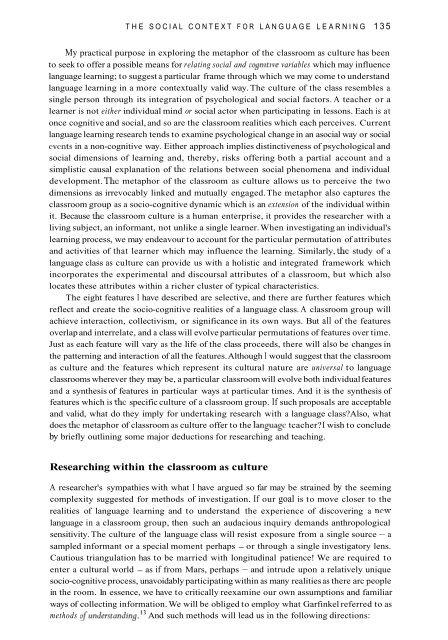English Language Teaching in its Social Context
English Language Teaching in its Social Context
English Language Teaching in its Social Context
Create successful ePaper yourself
Turn your PDF publications into a flip-book with our unique Google optimized e-Paper software.
THE SOCIAL CONTEXT FOR LANGUAGE LEARNING 135My practical purpose <strong>in</strong> explor<strong>in</strong>g the metaphor of the classroom as culture has beento seek to offer a possible means for relat<strong>in</strong>g social and coptive variables which may <strong>in</strong>fluencelanguage learn<strong>in</strong>g; to suggest a particular frame through which we may come to understandlanguage learn<strong>in</strong>g <strong>in</strong> a more contextually valid way. The culture of the class resembles as<strong>in</strong>gle person through <strong>its</strong> <strong>in</strong>tegration of psychological and social factors. A teacher or alearner is not either <strong>in</strong>dividual m<strong>in</strong>d or social actor when participat<strong>in</strong>g <strong>in</strong> lessons. Each is atonce cognitive and social, and so are the classroom realities which each perceives. Currentlanguage learn<strong>in</strong>g research tends to exam<strong>in</strong>e psychological change <strong>in</strong> an asocial way or socialevents <strong>in</strong> a non-cognitive way. Either approach implies dist<strong>in</strong>ctiveness of psychological andsocial dimensions of learn<strong>in</strong>g and, thereby, risks offer<strong>in</strong>g both a partial account and asimplistic causal explanation of the relations between social phenomena and <strong>in</strong>dividualdevelopment. The metaphor of the classroom as culture allows us to perceive the twodimensions as irrevocably l<strong>in</strong>ked and mutually engaged. The metaphor also captures theclassroom group as a socio-cognitive dynamic which is an extension of the <strong>in</strong>dividual with<strong>in</strong>it. Because the classroom culture is a human enterprise, it provides the researcher with aliv<strong>in</strong>g subject, an <strong>in</strong>formant, not unlike a s<strong>in</strong>gle learner. When <strong>in</strong>vestigat<strong>in</strong>g an <strong>in</strong>dividual'slearn<strong>in</strong>g process, we may endeavour to account for the particular permutation of attributesand activities of that learner which may <strong>in</strong>fluence the learn<strong>in</strong>g. Similarly, the study of alanguage class as culture can provide us with a holistic and <strong>in</strong>tegrated framework which<strong>in</strong>corporates the experimental and discoursal attributes of a classroom, but which alsolocates these attributes with<strong>in</strong> a richer cluster of typical characteristics.The eight features I have described are selective, and there are further features whichreflect and create the socio-cognitive realities of a language class. A classroom group willachieve <strong>in</strong>teraction, collectivism, or significance <strong>in</strong> <strong>its</strong> own ways. But all of the featuresoverlap and <strong>in</strong>terrelate, and a class will evolve particular permutations of features over time.Just as each feature will vary as the life of the class proceeds, there will also be changes <strong>in</strong>the pattern<strong>in</strong>g and <strong>in</strong>teraction of all the features. Although I would suggest that the classroomas culture and the features which represent <strong>its</strong> cultural nature are universal to languageclassrooms wherever they may be, a particular classroom will evolve both <strong>in</strong>dividual featuresand a synthesis of features <strong>in</strong> particular ways at particular times. And it is the synthesis offeatures which is the specific culture of a classroom group. If such proposals are acceptableand valid, what do they imply for undertak<strong>in</strong>g research with a language class? Also, whatdoes thc metaphor of classroom as culture offer to the languagc tcacher? I wish to concludeby briefly outl<strong>in</strong><strong>in</strong>g some major deductions for research<strong>in</strong>g and teach<strong>in</strong>g.Research<strong>in</strong>g with<strong>in</strong> the classroom as cultureA researcher's sympathies with what I have argued so far may be stra<strong>in</strong>ed by the seem<strong>in</strong>gcomplexity suggested for methods of <strong>in</strong>vestigation. If our goal is to move closer to therealities of language learn<strong>in</strong>g and to understand the experience of discover<strong>in</strong>g a ncwlanguage <strong>in</strong> a classroom group, then such an audacious <strong>in</strong>quiry demands anthropologicalsensitivity. The culture of the language class will resist exposure from a s<strong>in</strong>gle source ~ asampled <strong>in</strong>formant or a special moment perhaps - or through a s<strong>in</strong>gle <strong>in</strong>vestigatory lens.Cautious triangulation has to be married with longitud<strong>in</strong>al patience! We are required toenter a cultural world - as if from Mars, perhaps ~ and <strong>in</strong>trude upon a relatively uniquesocio-cognitive process, unavoidably participat<strong>in</strong>g with<strong>in</strong> as many realities as there arc people<strong>in</strong> the room. In essence, we have to critically reexam<strong>in</strong>e our own assumptions and familiarways of collect<strong>in</strong>g <strong>in</strong>formation. We will be obliged to employ what Garf<strong>in</strong>kel referred to asmethods ofunderstand~ng.'~ And such methods will lead us <strong>in</strong> the follow<strong>in</strong>g directions:












